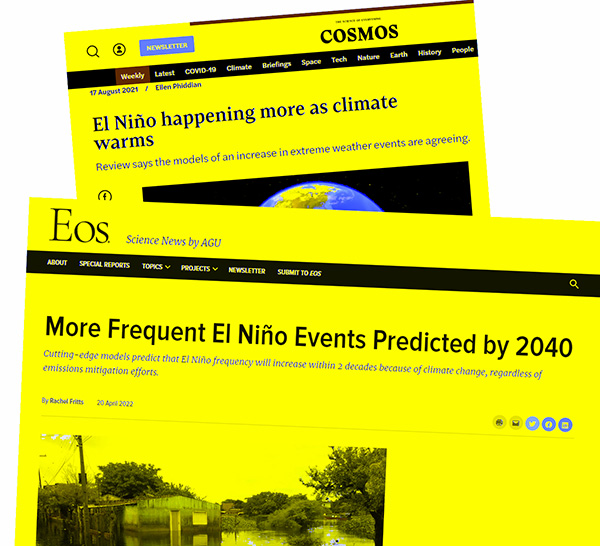ENSO is playing games with climate scientists — mocking their ability to predict the single greatest natural short term climate swing factor. The El Niño–Southern Oscillation drives floods, droughts, bushfires, and essentially pushes the planetary temperatures up and down on a year by year basis. Nothing determines the year’s climate headlines more than this one thing, yet climate scientists haven’t the faintest idea what drives it.
Imagine what it would look like if they could? They’d be able to say … blah… solar wind changes driven by, say, solar barycentric dynamics will lead to El Ninos in 2023, and ’25, a weak one in 2026. Farmers could plan ahead. Dam managers would know when water would be scarce. The UN would know which years to ask for even more money.
Instead we get this vague post hoc prophesy:
Rare ‘triple’ La Niña climate event looks likely — what does the future hold?
Nature
Meteorologists are forecasting a third consecutive year of La Niña. Some researchers say similar conditions could become more common as the planet warms.
On ongoing La Niña event that has contributed to flooding in eastern Australia and exacerbated droughts in the United States and East Africa could persist into 2023, according to the latest forecasts. The occurrence of two consecutive La Niña winters in the Northern Hemisphere is common, but having three in a row is relatively rare. A ‘triple dip’ La Niña — lasting three years in a row — has happened only twice since 1950.
Get ready: Matthew England predicts more triple events:
This particularly long La Niña is probably just a random blip in the climate, scientists say. But some researchers are warning that climate change could make La Niña-like conditions more likely in future. “We are stacking the odds higher for these triple events coming along,” says Matthew England, a physical oceanographer at the University of New South Wales in Sydney, Australia. England and others are now working to reconcile discrepancies between climate data and the output of major climate models — efforts that could clarify what is in store for the planet.
“Working to reconcile discrepancies” is climate-scientist-speak for “working to fix our broken models”. We note the get-out-of-jail clause on most climate news reporting, some scientists say this, some say that, so some climate scientists are always right.
How useful, exactly, are those models that predict a 51% chance of a La Nina seven months from now?
The latest forecast from the World Meteorological Organization, issued on 10 June, gives a 50–60% chance of La Niña persisting until July or September. This will probably increase Atlantic hurricane activity, which buffets eastern North America until November, and decrease the Pacific hurricane season, which mainly affects Mexico. NOAA’s Climate Prediction Centre has forecast a 51% chance of La Niña in early 2023.
When it comes to predicting what climate change will actually do to ENSO events — for years most scientists hedged and only say that both La Ninas and El Ninos may get more extreme, but not necessarily that one or the other will become more common.

Media Headlines. More Frequent El Nino Evnts predicted by 2040
Fortunately by 2019 the models were all converging….
El Niño happening more as climate warms
Review says the models of an increase in extreme weather events are agreeing.
According to Cai, extreme El Niño events happened roughly once every 20 years in the 20th century, but they’re now increasing in frequency. “It will almost double, to one in 11 years or so.”
He adds that there’s more consensus among the models they’ve examined than in previous studies, such as one he authored in 2015. “More models are saying the same thing. I think that it’s because we are now able to get more realistic models.”
And with exquisite timing just two months ago: